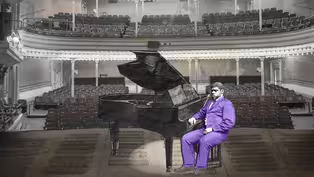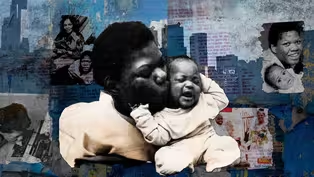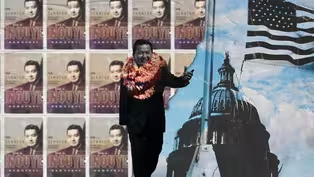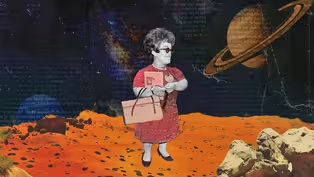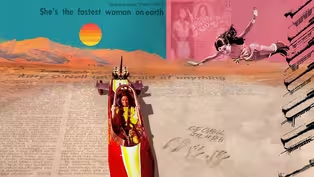
Brad Lomax: Creating Communities of Care
Special | 10m 19sVideo has Audio Description, Closed Captions
Explore Brad Lomax’s under-reported contributions to the early disability justice movement.
The story of a Black Panther Party member and founder of the East Oakland Center for Independent Living, who had multiple sclerosis and used a wheelchair. Explore Brad Lomax’s under-reported contributions to the early disability justice movement, which laid the groundwork for the 1990 Americans with Disabilities Act.
See all videos with Audio DescriptionADProblems playing video? | Closed Captioning Feedback
Problems playing video? | Closed Captioning Feedback
Support for American Masters is provided by the Corporation for Public Broadcasting, AARP, Rosalind P. Walter Foundation, Judith and Burton Resnick, Blanche and Hayward Cirker Charitable Lead Annuity Trust, Koo...

Brad Lomax: Creating Communities of Care
Special | 10m 19sVideo has Audio Description, Closed Captions
The story of a Black Panther Party member and founder of the East Oakland Center for Independent Living, who had multiple sclerosis and used a wheelchair. Explore Brad Lomax’s under-reported contributions to the early disability justice movement, which laid the groundwork for the 1990 Americans with Disabilities Act.
See all videos with Audio DescriptionADProblems playing video? | Closed Captioning Feedback
How to Watch American Masters
American Masters is available to stream on pbs.org and the free PBS App, available on iPhone, Apple TV, Android TV, Android smartphones, Amazon Fire TV, Amazon Fire Tablet, Roku, Samsung Smart TV, and Vizio.
Buy Now

A front row seat to the creative process
How do today’s masters create their art? Each episode an artist reveals how they brought their creative work to life. Hear from artists across disciplines, like actor Joseph Gordon-Levitt, singer-songwriter Jewel, author Min Jin Lee, and more on our podcast "American Masters: Creative Spark."Providing Support for PBS.org
Learn Moreabout PBS online sponsorshipMore from This Collection
Explore the lives of diverse, lesser-known historical figures with disabilities, exploring not only their impact on and contributions to U.S. society, but also the concept of disability culture, which honors the uniqueness of disability. Hosted and narrated by the musician and disability rights advocate Lachi.
Thomas Wiggins: Composing the Future
Video has Audio Description, Closed Captions
The story of a composer and pianist known as one of the greatest musicians of the 19th century. (13m 31s)
Celestine Tate Harrington: Building a Legacy
Video has Audio Description, Closed Captions
The story of a disabled street musician who fought for parental rights. (13m 3s)
Daniel K. Inouye: Life of Service
Video has Audio Description, Closed Captions
Explore the story of the U.S. Senator for Hawai’i who championed the cause of justice and equality. (12m 41s)
Judy-Lynn del Rey: The Galaxy Gal
Video has Audio Description, Closed Captions
Explore the story of a woman with dwarfism who revolutionized the world of science fiction writing. (12m 36s)
Kitty O'Neil: The Fastest Woman in the World
Discover "the fastest woman in the world," deaf racecar driver and daredevil Kitty O'Neil. (8m 55s)
Providing Support for PBS.org
Learn Moreabout PBS online sponsorship[Upbeat instrumentals] - He was so intelligent and truthful.
His persona projected that.
- Brad Lomax was one of those people that, as Black disabled people, we always saw his picture, but we never really knew who he was.
- Right.
- When we look at history of disability rights organizing, we see, of course, that there are a lot of white folks at the forefront.
Brad Lomax was dedicated to the work and not the limelight.
[Tender piano] - One in four American adults have a disability, and I'm one of them.
I'm Lachi, I'm a recording artist and disability culture advocate, and I'm here to introduce you to disabled renegades.
♪♪ I face each day as a renegade ♪ I'm sitting here at the Ed Roberts Building, one of the most accessible buildings in the nation, and we're going to be talking about Brad Lomax.
[Soft groovy instrumentals] Born in 1950, Lomax grew up in North Philadelphia during the height of the civil rights movement.
Like many Black families, the Lomax family faced redlining, economic segregation, and police violence, all of which would shape his future work.
- His mom was on the Poor People's March with MLK, and they were just taught that we were supposed to be active in the world.
We were supposed to be out making a difference.
- Right, in the family.
- When he was in high school, he went off down in the country and dug wells in impoverished communities.
He was a football player, was in school plays.
- An active kid.
- Yes.
[Lachi]: In 1967, Lomax graduated from Benjamin Franklin High School and soon enrolled in Howard University, where he joined the Black Panther Party.
Founded the year before, the Black Panthers were a paramilitary organization that advocated for self-defense and community empowerment, and fought against systemic discrimination.
Lomax's membership caught the attention of the FBI, whose files are one of the only written sources of information about his life.
Around that time, Lomax was diagnosed with multiple sclerosis, also known as MS, a chronic immune disease of the central nervous system.
MS affects both the brain and spinal column.
- In late high school, he started falling and went to the doctor and found out he had MS. - When most people think of the Black Panthers, they think of guns and militants, but there's a lot more to it, isn't there?
- What we know from Brad's FBI file, most of his days were spent building a health clinic in DC, a free health clinic for the neighborhood.
He was in charge of the first aid tent at the Black Panther Convention, also at the African Liberation Parade.
So he was always involved in making sure that people were healthy and had access to healthcare.
[Groovy instrumentals continue] [Lachi]: In 1973, his brother Glenn convinced Lomax to move to Oakland, California, the epicenter of the Black Panther world.
- The Panthers, we were dealing with a lot of social issues, the breakfast program, free busing to prison, these different programs, but we had nothing for disabled people.
And that's what Brad jumped on.
- I feel like there's a history there that doesn't typically get told.
The Center for Independent Living was supposed to cover Northern Alameda County, so Berkeley and Oakland primarily, but they covered Berkeley, and they kind of stopped there.
[Lachi]: The Center for Independent Living in Berkeley was the very first organization focused on assisting people with disabilities to live on their own, rather than with families or in institutions.
- The environment was very much focused only on white disabled people, primarily only on the issues relevant to white disabled men.
So Brad came in and said, "There's this entire population of disabled people of color that you are not serving."
[Upbeat instrumentals] [Lachi]: So Lomax opened a center of his own in Oakland, with support from the Black Panthers.
- From 1975 to 1977, he ran a Center for Independent Living in East Oakland.
- And this was a center that was servicing a generally Black area?
- Correct.
- We saw the barriers and obstacles people had to deal with to get to where they needed to get to, whether it was in the hospital, in an apartment, or just going down the sidewalk.
They're going to have to accommodate, because that's what they should do.
[Lachi]: In 1973, Congress had passed the Rehabilitation Act, the first major U.S. law to prohibit discrimination of people with disabilities.
But few actions had been taken to implement Section 504.
In response, on April 5th, 1977, hundreds of people with disabilities occupied federal buildings in major cities nationwide.
However, protests were shut down one by one, as the protestors were removed from or starved out of the buildings.
Lomax not only joined the sit-in at the Health Education and Welfare federal building in San Francisco, but also convinced the Black Panther Party to get involved.
[Upbeat instrumentals] - Because he had that smile and calm demeanor, you know, you'd have to listen to him.
The love in him just came out.
He was intelligent enough to convince that this needed to be done, and they couldn't stop him even if they wanted to.
- This is the federal building where the sit-in took place for 26 days, where Brad made the greatest impact towards social change.
- The Black Panthers came every day and fed us every day for the whole sit-in, and that's really quite frankly how we survived.
We wouldn't have survived without food from them.
- So with this 504 sit-in, the Black Panthers brought more than just meatloaf and chicken, didn't they?
- The Black Panther newspaper brought national coverage to the 504 sit-in.
The national news wasn't covering it, but the Black Panthers were.
- I was part of the group that was inside the building.
I happened to run into them in the hall and I said, "Can I ask you a question?
I don't get why you're doing this.
It's like a whole bunch of white people.
Like, why?"
And he said, "Because you're fighting for social justice.
We're going to support people who are going to fight to change the system.
And your willingness to put your lives in this building is something we want to support.
And Brad is here, and the organization was supporting Brad.
If the Black Panthers think that this is an important struggle, that's what we're going to do."
[Lachi]: The sit-in convinced the government to finally implement the accessibility requirements of Section 504, and paved the way for the 1990 Americans with Disabilities Act.
- We can clearly see with Brad Lomax and with the Panthers that there were already folks doing this expansive thinking about the relationship between all these systems of oppression and between all oppressed people, and committed to doing the work right then and there.
[Soulful melody] They were seeing that in their alignment with women's rights and with gay rights.
And so it was really easy for them to then apply that to disabled folks.
♪♪ You just don't love me the same ♪ - Labor of the coalition work really starts with making direct human connections with one another.
So I think that Brad's labor of just consistently connecting with the Center for Independent Living and making sure that the Panthers' buildings had wheelchair access.
They were doing these things that I think get really erased from the history of the Panthers.
- Do you know anything more about Brad after the sit-in?
- He continued working as a Panther in a health clinic, but at some point he was not able to work.
- Right.
- The MS had taken over.
- Mm-hmm.
- But he was still living in a Panther abode.
His brother had to go get him.
- He was getting mentally incapacitated around that time, '79, so he didn't really know what was going on.
[Lachi]: In the last years of his life, Lomax's family cared for him at home.
He died in 1984 from complications of his MS. What is Brad Lomax's legacy?
- He was the beginning of disability justice, because of his work with the Black Panthers intersecting Blackness with disability.
He was already there and all of the people that are working on it now, we're all his children continuing that work.
- I think the bridge work that so many of us that are multiply marginalized and live within multiple marginalized communities, that we are often connecting these communities to save ourselves, but also to recognize the way that working together is the only way that we can save all of our communities.
[Chiming instrumentals] - He departed this life on August 28th, 1984.
He was born in Philadelphia, Pennsylvania.
He later attended Howard University in Washington DC, where he became interested in community programs.
Although he was being destroyed by multiple sclerosis, a crippling disease, he remained involved in the struggle of helping others.
Through his trials, he became noted for his trademark, which was his smile.
Your fight is over, Brad.
We loved you, but God loved you best.
[Tender guitar instrumentals] [Clap]
Support for PBS provided by:
Support for American Masters is provided by the Corporation for Public Broadcasting, AARP, Rosalind P. Walter Foundation, Judith and Burton Resnick, Blanche and Hayward Cirker Charitable Lead Annuity Trust, Koo...

